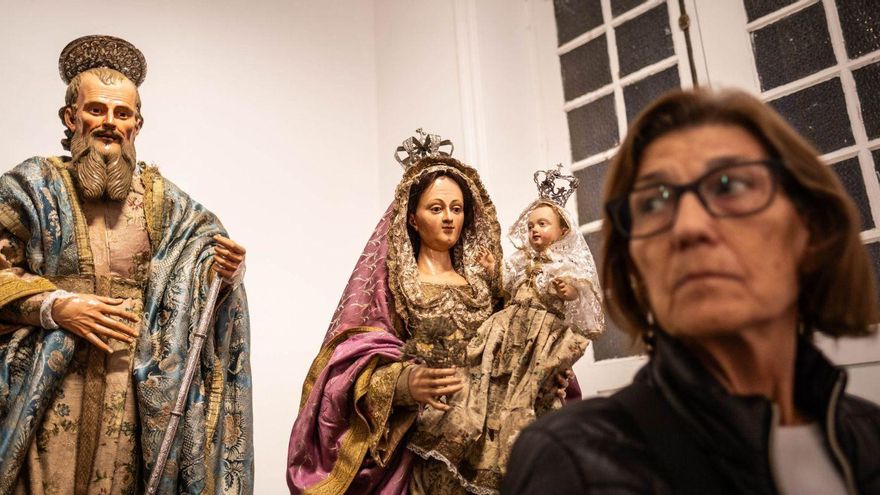
Christmas as the great work of art of the Child-God. This could be the title of the exhibition that, under the title The Nativity Scene Among Us and which can be visited until January 7, has been presented since yesterday in the two temporary rooms that They are dedicated to Tarquis and Pedro Gonzalez in the Municipal Museum of Fine Arts, next to the Plaza del Príncipe in the capital of Tenerife.
A total of fifty-four works of art, including paintings and imagery, are displayed in the municipal museum thanks to the initiative undertaken by the parish of San Francisco de Asís and which has had the support of the Santa Cruz City Council, the Nivariense Bishopric and individuals.
Among the pieces of greatest artistic value, some that date back to the Baroque – up to the 17th century, the oldest; some contributed by the Museum itself, a large number arrived from temples of the Diocese, such as the parishes of La Concepción or the church of San Juan, in La Orotava; the Cathedral of La Laguna, San Marcos, in Icod de los Vinos, the Las Catalinas convent, in La Laguna or even the promoting church itself.
The parish priest of San Francisco de Asís and diocesan delegate for Heritage, as well as a doctor in Church History from the Gregorian University of Rome, Miguel Ángel Navarro Mederos, explained that the idea of organizing this exhibition came from his community, coinciding with the 800th anniversary of the celebration of the first nativity scene, precisely in charge of Saint Francis of Assisi, owner of his temple in Santa Cruz de Tenerife.
But it is an activity within the premise that presents the Church “as a generator of Culture, where the main work of art is the love story that God creates. It cannot be that we keep this exclusive for ourselves, but we must show it to others, express the presence of God so that the world can know him,” explains the priest, who preaches, over and over again, “the love for Christ”.
And under that premise of “the beauty of God among us”, Miguel Ángel Navarro Mederos says that the objective of these activities that have been organized together with the exhibition in the Municipal Museum is to return or recover the meaning of Christmas, from something so banal as giving an account of why the streets are decorated these days with lights, in reference to Jesus Christ as the light in the world, or why the year changes from December 31 to January 1.
The exhibition The Nativity Among Us is just the justification to account for the origin of the history of salvation, with pieces that recreate the mystery of sin, with Adam and Eve; Mary Immaculate Conception, the Motherhood of Mary, the Annunciation, the Birth or Nativity, the Adoration of the Three Wise Men to how this custom has been installed in Santa Cruz homes by private collectors.
From Greccio to Tenerife
The parish priest of San Francisco and diocesan delegate of Heritage goes back to the origins of the nativity scene and specifies that this year marks eight centuries of the initiative undertaken by the deacon raised to the altars when he left his Assisi to make a trip through the Holy Land and Egypt in 1219 he encountered the mystery of Bethlehem and, to his disappointment, found wars and division between Christians and Muslims.
Hence, upon returning to his homeland, he decided to represent a living nativity scene with the town of Greccio, which resulted in an exhibition with figures. Thus was born the popular nativity scene that has remained a custom ever since and in different styles.
Precisely this Saturday, December 16, at 8:00 p.m., the parish of San Francisco will host a sacramental auto of the Three Wise Men, very similar to the one recreated by the pioneer of nativity scenes, which will take place in the aforementioned temple with the collaboration of the group of theater of the Círculo de Amistad XII de Enero and under the direction of the historian Gerardo Fuentes.
The Councilor for Culture, Santiago Díaz Mejías, points out that this exhibition “brings together works of great pictorial value, of baroque and contemporary style, among which a painting by the Canarian artist Juan de Miranda stands out.”
The curator of the exhibition, art historian and academic at the Royal Academy of Fine Arts, Gerardo Fuentes, explains that “this exhibition attempts to take a tour prior to the birth of Christ, to end in the manger and also represent that special moment that is inseparable from Christmas, which is none other than the presence of the Three Wise Men. The opening ceremony was also attended by the Minister of Culture of the CouncilJosé Carlos Acha.
















